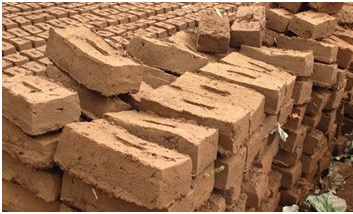Types of bricks used for construction!
Bricks are the key ingredients of any constructional structure. A brick is basically used in most of the masonry construction and they are arranged or stacked together, to form a definite shape or structure. The bricks are further incorporated with mortar and cement mixture, to form a permanent and solidified structural unit of the construction. In any constructional work, large amounts of bricks are required to complete building work. Bricks are considered to be the most durable structural component, which is responsible for the long lasting ability of any construction. The branded brick manufacturing companies adopt the accurate procedures in manufacturing of best quality bricks. Hence, it is extremely important to use those best quality bricks in the construction work.
Let’s know the different types of bricks used in Indian Construction.
- Sun-Dried Bricks

Also called unburnt bricks, these are one of the most primitive examples of bricks; these types of brick was not burnt in kilns but were dried in the sun for hardening. Sun-dried bricks are less durable, have less water resistance and less fire resistance. These are mostly used in rural areas or in constructions that are temporary. The process of making these bricks involves 3 simple steps, i.e. preparation of clay, molding, and finally sun drying.
- Burnt Clay Bricks
Burnt clay bricks are the oldest and most widely used construction material. These are superior quality bricks and are used in the construction of many vital structural members like walls, columns, foundation, etc.

Burnt bricks are classified into 4 different types, these are:
- First-Class Bricks – This category of burnt clay bricks complies with all the quality of good bricks. These are table molded and are burnt in kilns. These bricks hold standard shape, smooth surfaces, and sharp edges and are more durable and have more strength.
- Second-Class Bricks – These bricks are of moderate quality. These are ground-molded and then burnt in brick kilns. The shape of these bricks is irregular, and the surface isn’t smooth but rough. In addition to this, these bricks can have hair cracks. This class of bricks is used in places where the brickwork is covered with a coat of plaster.
- Third-Class Bricks – As the name suggests, these are poor quality bricks which are normally used for structures that are temporarily constructed. Note, these are not suitable for areas that receive a lot of rain. Third Class bricks are molded on the ground and are further burnt in clamps. The surface of this category of bricks is rough and these have edges that are unfair.
- Fourth-Class Bricks – These are over-burnt, irregular shaped and dark in color. This class of bricks is used as the aggregate for concrete in foundations, roads, floors, etc. Owing to its compact structure, these bricks are sometimes found to be stronger than the first-class bricks.
- Fly Ash Bricks

Fly ash brick is a building material that is specifically used in masonry units. It contains class C or class F fly ash (a byproduct of coal burning) and water that is fired at around 1,000 degree Celsius. Due to the high concentration of calcium oxide in class C fly ash, this type of bricks is every so often described as “self-cementing”. Typical uses for fly ash clay brick are in structural walls, pillars, and foundations.
- Concrete Bricks

Concrete bricks are made using solid concrete along with ingredients like cement, sand, coarse aggregates, and water. The sizes of these bricks can be tailored according to the size requirements. These are commonly used in facades, hidden/internal brickworks, fences, and tend to provide an outstanding aesthetic presence.
- Engineering Bricks

#5 on our types of bricks list are the Engineering bricks. These have high compressive strength and are used for special applications where strength, acid resistance, low porosity, frost resistance is essential. Engineering bricks are most commonly used for basements; this is because in these areas chemical or water attacks are quite prevalent.
- Calcium Silicate Bricks

Calcium Silicate Bricks also commonly known as Sand lime bricks, these are made by mixing lime, sand, and fly ash. This type of bricks is used for numerous purposes in construction industries like masonry works, ornamental works in buildings, etc.
7. Hallow or Eco Bricks

Hallow bricks are smart walling material that peruses the advantages of natural clay. These are perforated hollow bricks, which can be either horizontally perforated (HP) or vertically perforated (VP). The fact that they are made of natural substances and are hollow from inside makes them far more efficient than the traditional solid bricks and blocks.
Please feel free to contact me if you need any further information. Please let me know if you have any questions.
Mobile/WhatsApp No: +91 9963-277-542
Email: info1@kreativehouse.asia
Address 1: Flat No.302, 1st Floor, Sree Homes, Plot No.51, M.B.Society, Hitech City Main Rd, Hyderabad, Telangana 500084.
Address 2: Regus Pune Metropolitan Business Centre Pvt Ltd, Baner, Pune 411045
Subscribe to Kreativehouse:
YouTube: www.youtube.com/channel/UCLYGdZagVC7I8vSaS4-7iyg
Like us on Facebook: www.facebook.com/kreativehouse.asia
Follow us on Linkedin: www.linkedin.com/company/kreative-house
Follow us on Twitter: www.twitter.com/KreativeHousee
Follow us on Pinterest: www.pinterest.com/Kreative_House
Follow us on Instagram: www.instagram.com/kreative_house_hyd_pune
View Blogspot: www.kreativehousehyderabad.blogspot.com

